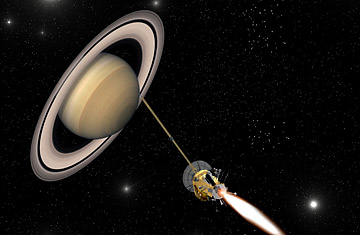
An artists impression provided by the European Space Agency ESA shows the 'Cassini-Huygens' spacecraft firing its rocket to insert into the orbit of planet Saturn.
The moons have always been the solar system's B Team. Everyone knows the order and names of the eight great planets — a club that's gotten even more exclusive since Pluto was demoted in 2006. But the 174 moons that circle six of those planets? Cosmic proletariat.
The moons, of course, are worth getting to know — and in many cases are far more interesting than the parent worlds they orbit. There's watery Europa and fiery Io circling Jupiter; there's bitter cold Triton clinging close to Neptune; there's the exquisitely named Cordelia, Ophelia, Juliet, Portia, Miranda, Belinda and Puck circling Uranus. And then there's Saturn's Titan, a moon that has long fascinated astronomers for its huge size, its opaque atmosphere, and its rich chemistry that literally drips with organic molecules. Now Titan has gotten more interesting still: According to just-released findings from the Cassini spacecraft, the moon also has a scattering of methane lakes in its tropics — one that's half as large as Utah's 21,500 sq. mi (55,685 sq. km) Great Salt Lake — making it the only known world apart from Earth to have anything of the kind.
At the heart of everything that makes Titan so intriguing is its methane — a fundamental ingredient of biology and a chemical precondition for life as we know it. Nothing remotely living has ever been spotted on the miasmic moon, but methane has other roles to play. Infrared imaging had long detected dark spots on Titan's surface, which astronomers theorized might be vast pools of methane, perhaps as large as an ocean. When the Cassini spacecraft arrived at Saturn in 2004, it fired a probe, dubbed Huygens, into the Titanian atmosphere, where it deployed a parachute and descended to the surface at a spot in the tropics known as Shangri-La. In the instants before the atmospheric pressure crushed the life out of it, Huygens signaled home the tantalizing news that its on-board lamp had vaporized a bit of methane from the surface. The probe, it appeared, had landed in a swamp.
There was plenty of reason to believe those findings could be in error. Just as Earth has a global water cycle, Titan is thought to have a global methane cycle — and the two work essentially the same way. At the marginally warmer equatorial regions of Titan, liquid methane evaporates and rises into the atmosphere. Prevailing winds carry it north and south until it finally reaches the global poles, where cools, rains out and pools on the ground. Methane rain has in fact been detected numerous times at the poles, but only once in the tropics, and that was during the moon's rainy season. (Yes, Titan has one of those too.) Polar lakes would not be a surprise then; tropical ones would be another matter — and they'd be hard to explain.
But the new infrared readings of Shangri-La and the vicinity confirmed that the lakes are there, and while they're not terribly deep — perhaps three ft. (1 m) or so — they spread wide. The question was, What's keeping them full? And the answer, NASA scientists believe, is another feature borrowed from Earth: underground springs that continuously percolate up, feeding the lakes with liquid methane from the bottom even as they evaporate away at the top.
"[The] likely supplier is an underground aquifer," says Caitlin Griffith, a member of the Cassini team and the lead author of the paper just published in Nature that reported the findings. "In essence, Titan may have oases. The discovery was completely unexpected because lakes are not stable at tropical latitudes."
So Titan has organic chemistry, Titan has weather and now we know Titan has tropical lakes. Is it too much of a stretch to suggest that Titan might also have at least primitive life — especially since the first organisms on Earth emerged in equatorial oceans and seas? Alas, it's indeed too much. Titan's paralyzingly cold, -290 F (-179 C) temperatures are way too harsh for anything approaching biology as we know it to begin to stir. But that doesn't mean there's not a lot to learn even from so sterile a place.
The ancient Earth is thought to have been very similar to the modern Titan — chemically if not thermally. A good, close look at Titan is thus something akin to taking a good close look a flash frozen version of the early Earth, at the very moment it was teeing itself up for life. That can help us learn how we've gotten where we are today — even if Titan itself will never get there too.
"Cassini still has multiple opportunities to fly by this moon going forward," says Cassini project scientist Linda Spilker. "We can't wait to see how the details of this story fill out." It's hard to say what will be found in those later chapters of the spacecraft's mission, but the earlier ones suggest remarkable things.
